This post was long due in my to-do list. A lot has been done in the background since I started working on the Imaging Wiki, and the last IWG quarterly meeting was the ultimate opportunity to collect notes and thoughts into a narrative that I could share with the community.
This is a Wiki update like you've never seen before: it is long and juicy. You will learn about the goals that we set for the Wiki 2.0, the big decisions that we took and why, and the strategies we are implementing to keep track of our work.
*** Before diving in, I want to thank Jeff, Tessa, Adam and Keats for the trust that they have placed in me since day one. This project is ambitious and requires a lot of bold decisions, and not once I felt that I was doing it alone: that's why I use the third person (we) to describe the work done so far. ***
Alright – fasten your seatbelts.

The so-called Wiki 1.0
A bit of context for the readers who don't know the origin story of the Imaging Wiki.
It all started in 2020, when the COVID-19 pandemic left us with plenty of time to ponder what to do with so much free time, and with a massive urge to socialise. The IWG founding members (Jiuan Jiuan, Dawn, Dale, Anna and Keats) gathered tens of students, young professionals and senior veterans from the imaging field around the world with the ambition to create the Imaging Wiki.
The mission was clear from the start: to create an accessible knowledge base of the collective experiences, best practices and resources for whoever wants to approach technical imaging for cultural heritage. It was an incredible success!
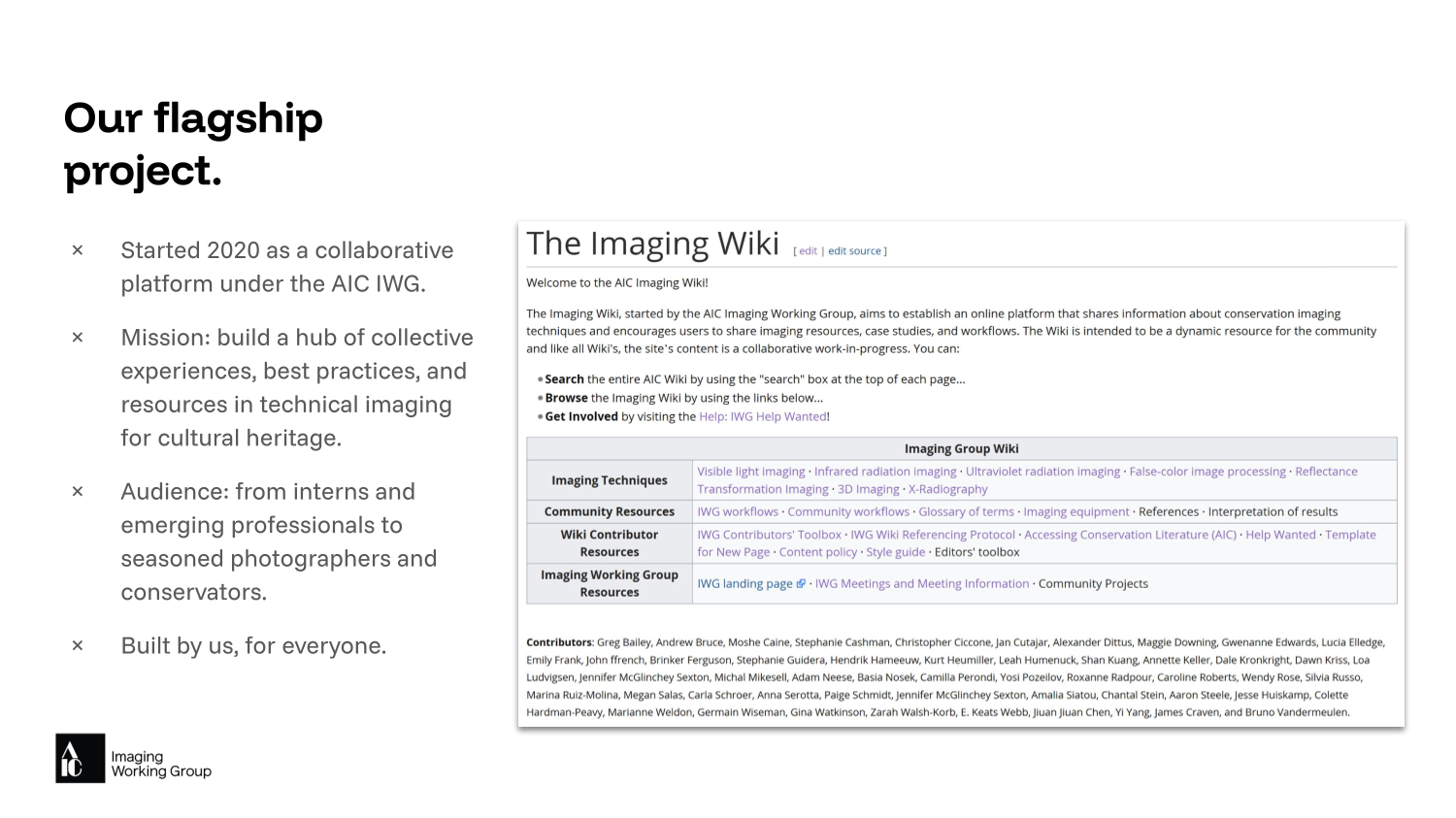
Now, bear with me because what happened has impacted the Wiki to the present day.
The way the Imaging Wiki was initially designed followed a linear structure, pretty much like a book with chapters. The Wiki was put together by topic groups, or task forces of professionals knowledgeable in one or more techniques, with one or more topic group Leads to manage and oversee the progress. Each page contained everything there's to know about the techniques under a common criterion (the main radiation source). Each group managed and developed the respective contents according to their needs.
After this huge push, the IWG reached what we call a "Wiki burnout", where little to no contributions landed: a new leadership recognised that we were more than creators of contents and [successfully] focused on the growth of the community.
Alas, built with the best of intentions, the arrangement of the Wiki 1.0 posed several limitations in terms of maintenance, navigation, and consistency.
-
Because topic groups worked independently, editorial choices varied significantly. This resulted in a limited accessibility due to the unfamiliar and inconsistent distribution of content across the Wiki.
-
The topics were developed in parallel and at different paces, leaving little opportunity to effectively link articles to each other and create a sense of cohesion.
-
The dense walls of text of some articles left little margin to expand or elaborate on information without breaking the page's flow.
-
Elaborate technical definitions were often included directly in the main text, which inevitably disrupted the narrative flow and user experience.
-
Lastly, the decision to list the contributors on each page inadvertently created a sense of ownership of the content discouraging other contributors, particularly students or emerging professionals, from proposing necessary edits.
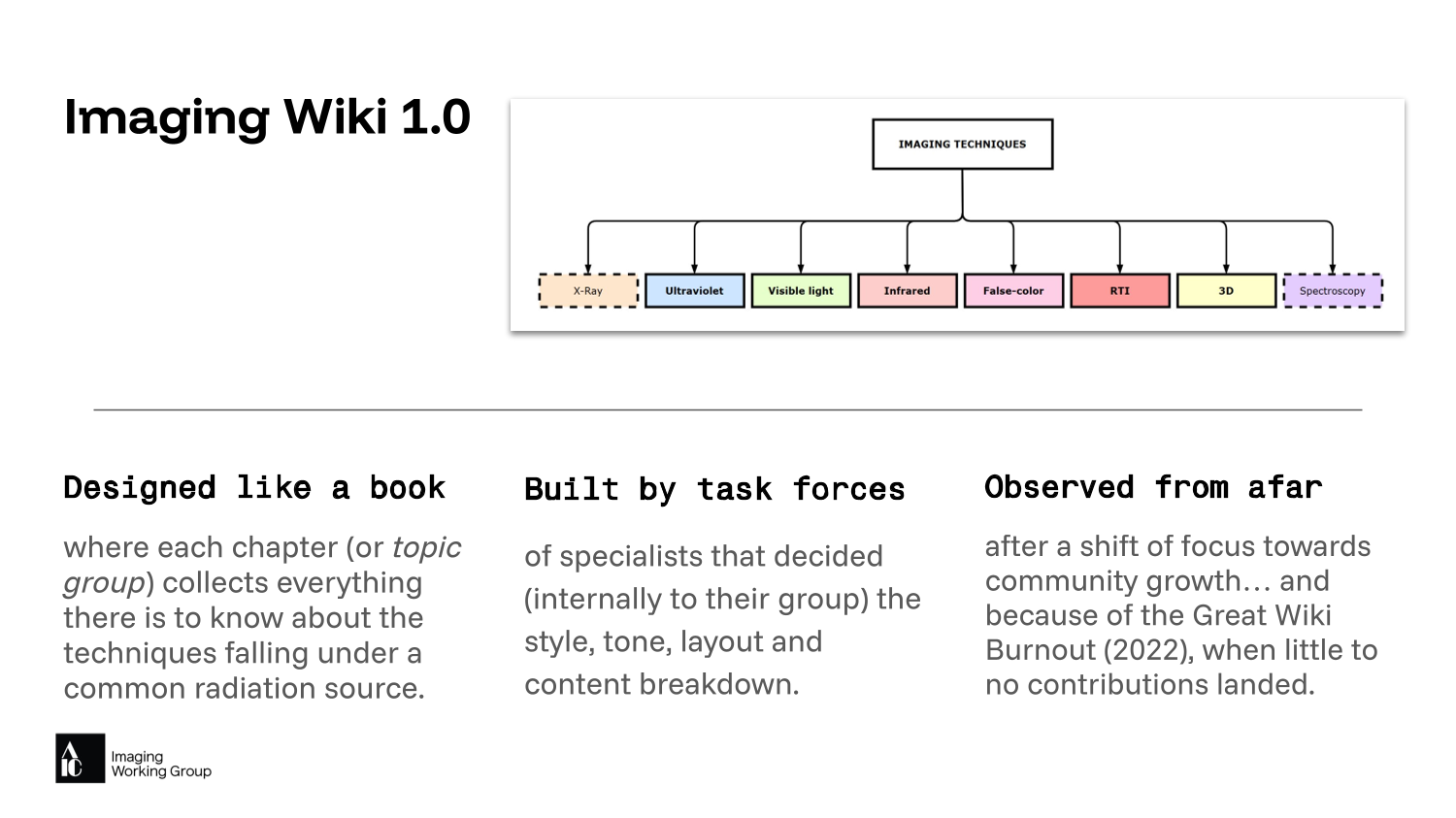
Towards the Wiki 2.0
Flash forward to 2025, the new IWG leadership expressed a renewed interest in the Wiki. After all, so much sweat and tears were shared in its making, it would be a shame to let it go.
And here is where I come in. At the interview for the position of IWG Wiki Coordinator I presented a rough plan of what I would have done to the Wiki if I got the position: charts, tables, milestones… Everything looked nice and polished, but what I was truly asking was: "Can I butcher this thing?" I'm so grateful that they not only invested me with the role, but also accepted my terms: kill your darlings as the only way to see change.
For every project worth its name you need objectives, a strategy, and tools to measure progress. Let's start with the objective:
By summer 2027, all the contents and media of the topic groups will be reviewed, the taxonomy of the Imaging Wiki restructured, and the contribution processes redesigned to ensure high content accuracy, easy navigation, accessibility, and engagement from the community.
Specific, measurable, achievable, relevant, time-bound. Boom, easy.
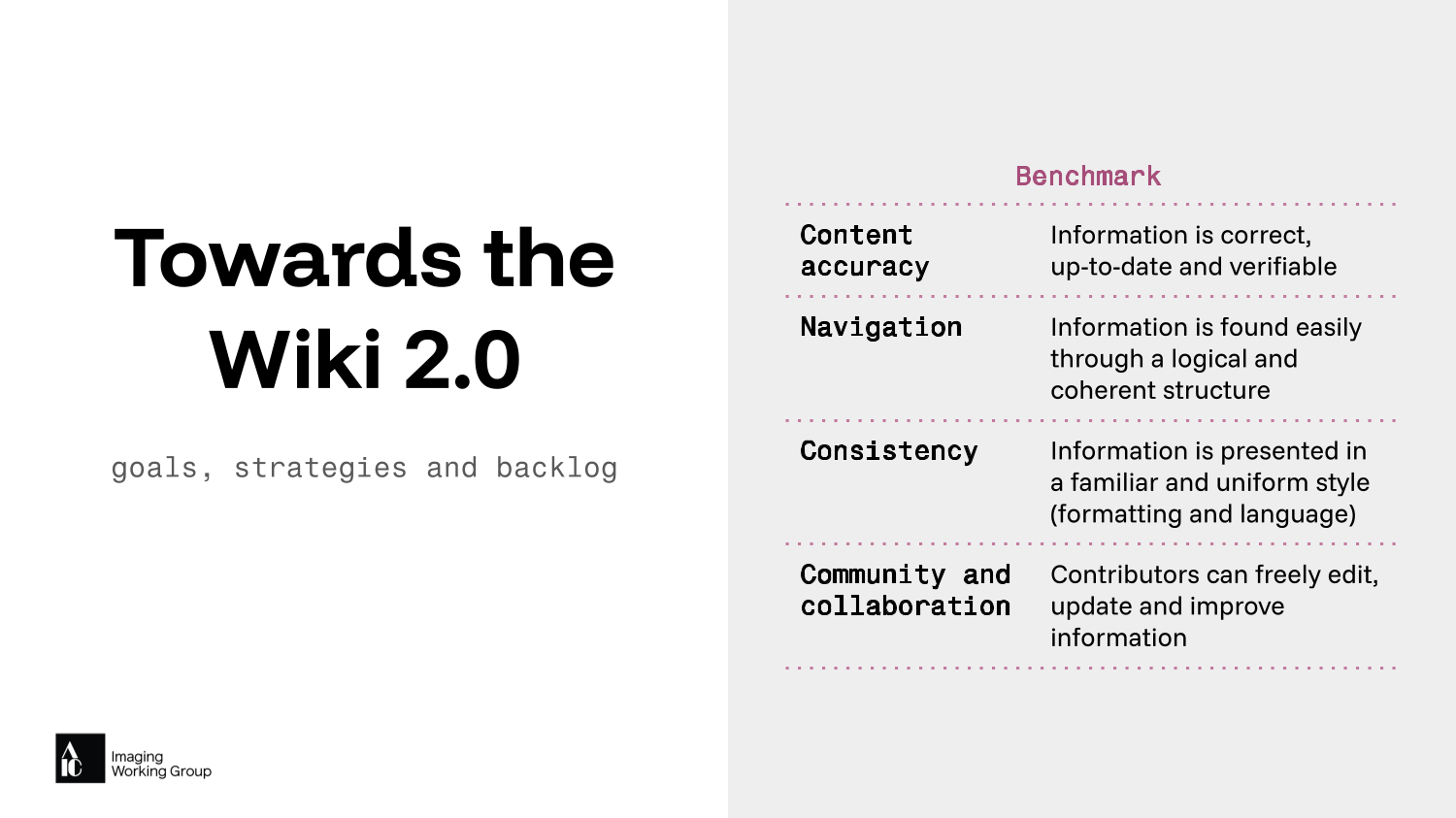
Planning the strategy was a labour of love – and reverse engineering.
Phase 1. Since we want consistency, we need rules.
Phase 2. Based on these rules, we review and adapt the content that we already have and consolidate it.
Phase 3*. Once we have solid foundations, we implement hassle-free contribution mechanisms.
* Although some conversations are happening on this topic, this milestone is still too far in time. I'll let you know when, no worries.
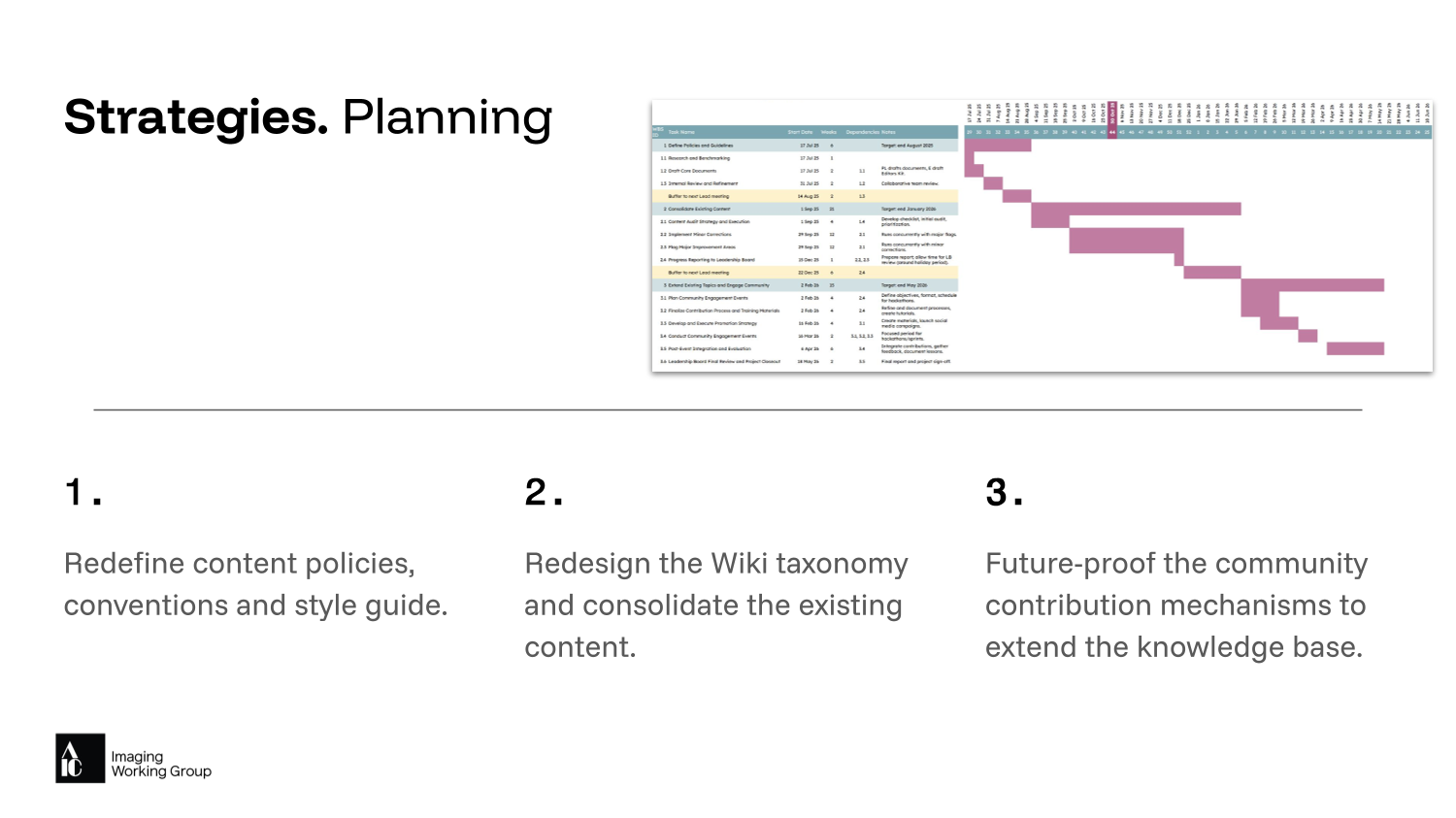
Phase 1: the rules
Phase One [pun intended] consisted in creating common rules that apply for everyone across the Imaging Wiki. We didn't start from scratch; we expanded the AIC Wiki Guidelines, built upon the BPG Community Guidelines, and took inspiration from Wikipedia. This mix of sources was intended to retain the values shared among the AIC Wiki specialty groups, as well as to learn from the most established Wiki online. One big leap that we took was to not recognise the authorship of the individual pages because we believe that i) any contribution counts, whether it's a link to a conference recording or seven paragraphs on colour management; and ii) the Imaging Wiki is not a scholarly publication, but a resource open to everyone. The list of all contributors, old and new alike, remains visible in the Imaging WIki home page.
So, the IWG Content Policy and the IWG Style Guide were born to answer two fundamental questions:
What information should the Imaging Wiki contain? (Content policy)
And how do we present it? (Style guide)
Despite being two separate documents, they share common scopes:
-
To guide the contributors and editors in the quick decision-making
(e.g., "where do I place this image?", "when can I add a Wikilink?", "is this content enough to create a new article?").
-
To establish consistency throughout the Imaging Wiki pages.
-
To provide a baseline to assess the condition of the existing contents.
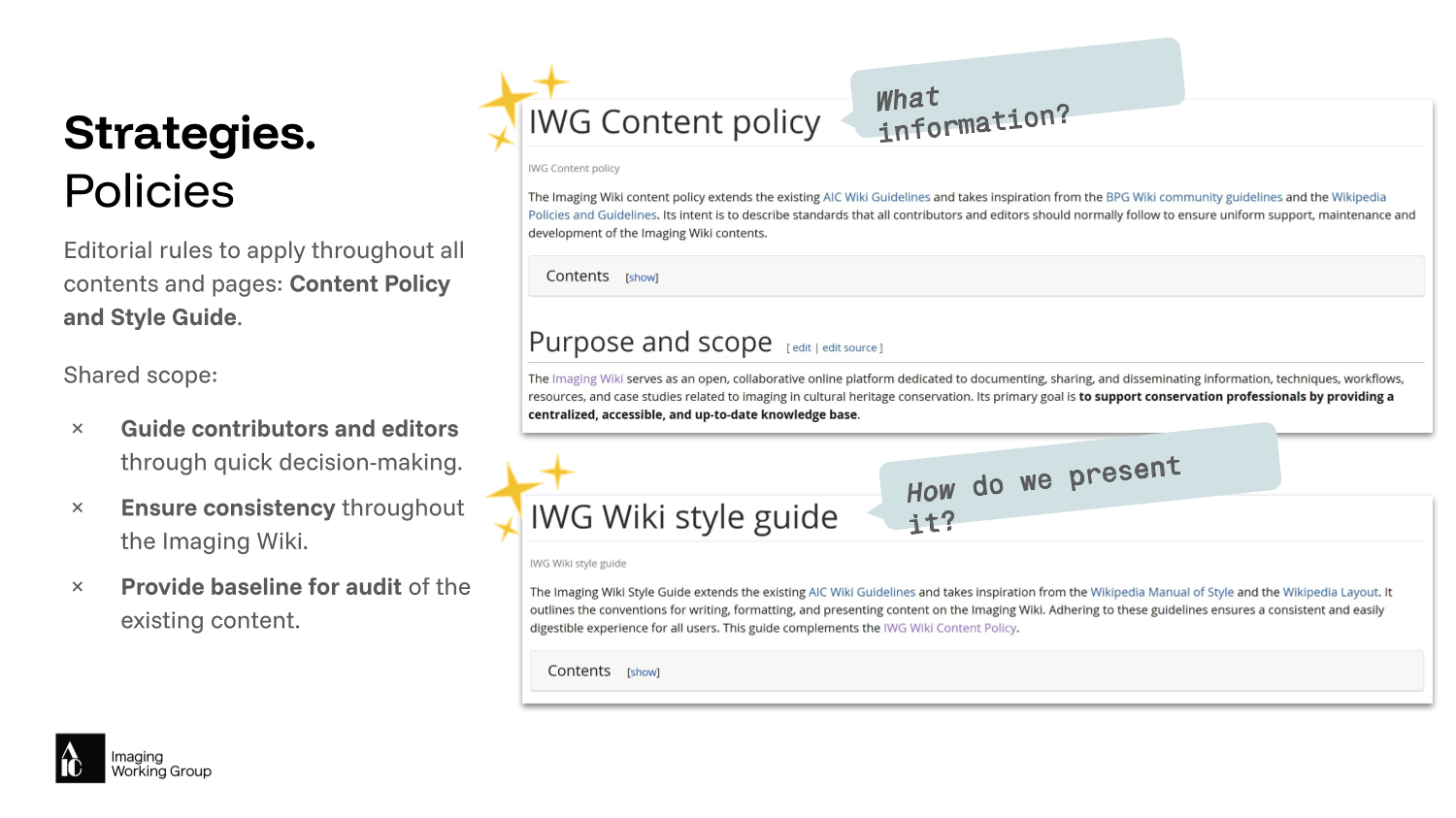
Phase 2: "can I butcher this thing?"
Then it was time to audit the existing articles. We took each individual point of the Content policy and the Style guide and put them on a spreadsheet to create a checklist where each point was expressed in the form of a question with binary (Yes/No) answers. All the main articles were audited the same way using the checklist (back in July 2025 the checklist was a list of 102 questions), and based on the results we obtained a compliance rating to the new guidelines (a straight proportion of No's against the total Yes/No's). The compliance rating, as expected, varied greatly between articles.
The audit was a good exercise to identify inherent issues and prepare a plan to address them strategically. Each article had its own complications that couldn't be described neither with a Yes/No answer or a number. For example, the article with the highest rating (70.27%) was a wall of text where information is repeated in visual patterns, making it really hard to locate at a glance a single piece of information.
The pilot editing project on the Visible light imaging articles was not a stroll in the park… We had to think in multiple dimensions: macro to micro and back, structure and narrative flow, text and visuals. Giving shape and meaning to it, all the while paying respect to the work done by our peers. We edit the texts on Google Drive, keep a list of illustrations with links so they won't be forgotten, and implement the edits on the Wiki in bits and pieces, even when just a paragraph or a section is ready. It doesn't look nice, but it's a constructive and non-destructive method.
At the end of the pilot project we ran a validation test using the same audit checklist. Seeing the articles passing the test with full grades was truly satisfying.

Phase 2: "where do I put this?"
Do you remember the linear, book-like structure in the beginning? Well, forget it.
During the pilot project, on numerous occasions we had chunks of content that wouldn't fit in the main article because they would have broken the narrative flow, but were too relevant and interesting to leave them behind. Creating a new article was an obvious choice, with the benefit of flexibility to expand the content in the future. But…how do we organise all these articles? How do we make sure that all the articles can be easily found? What shape do we imagine for this taxonomy?
Since we are at the very beginning of a major transition process, the solution that we found is a leap of faith.
-
We create new articles whenever necessary to avoid verbosity within the same article and promote redundancy across the Wiki;
-
We organise all the articles semantically, exploiting the power of categories and sub-categories, to offer multiple access points to all contents;
-
We promote internal links (or Wikilinks) across the whole AIC Wiki to offer the typical "rabbit-hole" navigation style and enrich the contents.
[I know you're curious: that cool map was created with Gephi. Yes, those are all the Imaging Wiki articles and how they link to each other. And yes, it took a while to make].

Stage and backstage
The results of the pilot project on the Visible light imaging contents met the expectations: the narrative flow and the accessibility have improved significantly, as well as the navigation via Wikilinks. There is still much work to do, and not just on the formerly known topic groups.
The backend housekeeping always brings surprises (like forgotten articles and broken links), and an open communication is kept open with all the parties involved (IWG leadership, the community, and the Wiki coordinators from the other specialty groups) to raise discussions on relevant topics, bugs and procedures.
As mentioned, there's so much to do that this project is not made for one person alone. There is an open call for editors to join the editorial team and form a task force specifically on the transition to the Imaging Wiki 2.0 (thank you for spreading the word)!


Next steps
So, there you have it: the full, unvarnished story of our journey toward Wiki 2.0.
While we've made substantial headway, the real work of filling out the new structure has just begun. We're counting on the new guidelines and the support of our upcoming editorial team to carry the torch forward. I will try and make it a habit to post a monthly Wiki update right here on the forum, keeping you informed on our progress, setbacks, and next priorities.
Thank you for your continued trust and for letting us break a few things in the service of building something better.
------------------------------
Camilla Perondi
Conservation Scientist / Imaging Specialist
Copenhagen
Denmark
------------------------------